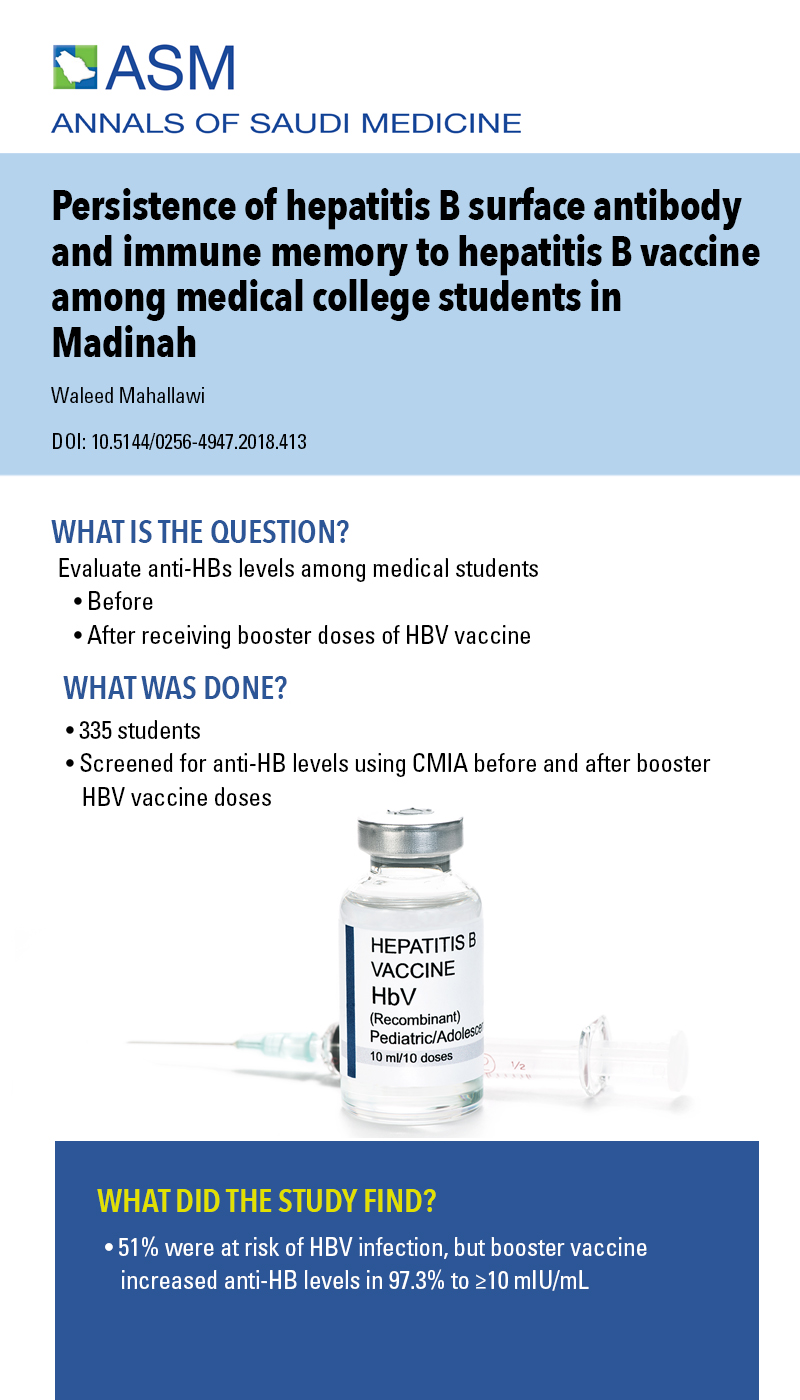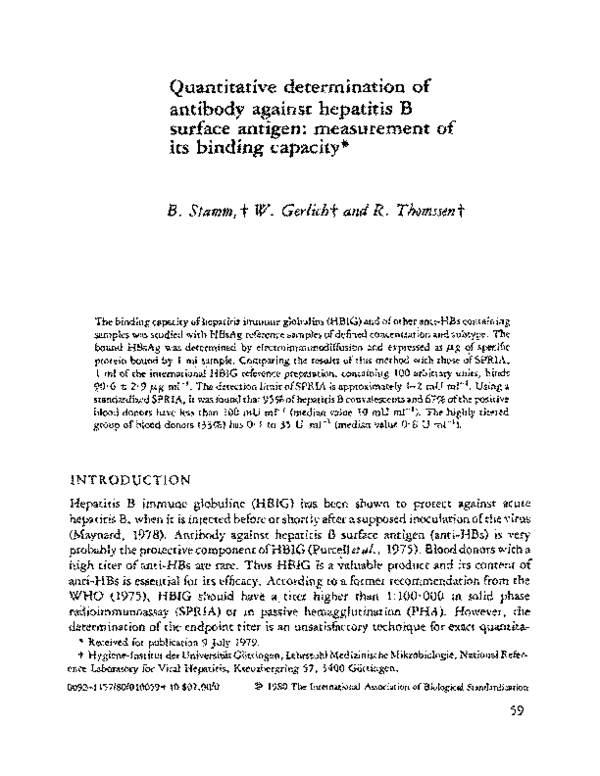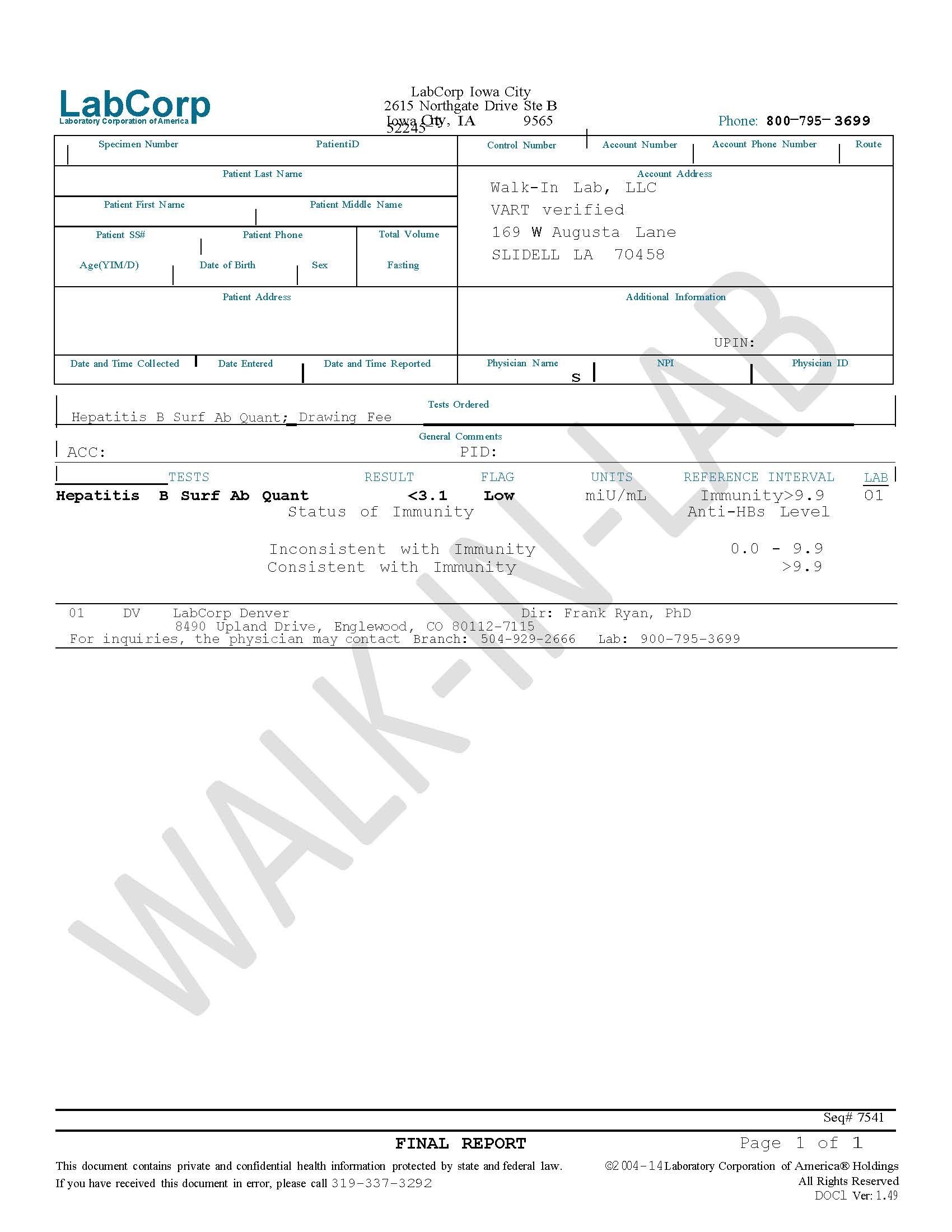What Is A Hepatitis B Surface Antibody Test
Hepatitis B surface antibody test is part of a panel of blood tests to diagnose HBV infection. Hepatitis B surface antibody test determines the presence and quantity of anti-HBs in the blood serum, which can indicate protection from HBV infection.
Hepatitis B disease affects the liver and commonly spreads through body fluids such as blood, semen, and vaginal secretions.
What Is Hepatitis B Surface Antibody
When you are exposed to hepatitis B, your body mounts an immune reaction against it as an invader. This happens whether you are exposed due to blood or sexual contact or if you are vaccinated with the hepatitis B vaccine.
The hepatitis B virus has proteins on its surface that cause your immune system to produce antibodies. With the vaccine, the sample contains the protein only and not the virus itself.
The first response your body will make when exposed to hepatitis B is to manufacture hepatitis B IgM antibodies. These early antibodies are produced to fight against several parts of the virus including its core. These antibodies are seen in the initial response, but they eventually fade away.
Your immune system then begins to produce IgG antibodies. It continues to produce these antibodies for the rest of your life. In this way, your immune system is always ready to attack hepatitis B virus when it is exposed to it.
Hepatitis B Surface Antibody
- Hepatitis B Surface Antibody
- Description
-
The Quantitative detection Hepatitis B virus Surface IgG antibody in human sera using the FDA approved Abbott ARCHITECT AUSAB-DIL test two-step chemiluminescent immunoassay.
In the first step, sample, assay diluent, and recombinant Hepatitis B surface Antigen coated paramagnetic microparticles are combined. Anti-HBs present in the sample binds to the rHBsAg coated microparticles. In the second step, rHBsAg acridinium-labeled conjugate is added, which binds to IgG anti-HBs. Then pre-trigger and trigger solutions are added to the reaction mixture. The resulting chemiluminescent reaction is measured as relative light units .
A direct relationship exists between the amount of anti-HBs in the sample and the RLUs. The concentration of anti-HBs in the sample is determined using an active ARCHITECT AUSAB calibration curve. Results are reported as mIU/mL.
For Batteries containing HBSAb see:
Hepatitis B Antibodies , Quantitative detection of Hepatitis B virus Surface IgG antibody and Hepatitis B virus Core IgG and IgM antibodies
Hepatitis B Battery , Quantitative detection of Hepatitis B virus Surface IgG antibody , Qualitative detection of Hepatitis B virus Surface Antigen and Qualitative detection of Hepatitis B virus Core IgG and IgM antibodies
Hepatitis B Surface Antigen & Antibody , Quantitative detection of Hepatitis B virus Surface IgG antibody and Qualitative detection of Hepatitis B virus Surface Antigen
- Synonyms
Recommended Reading: Antiviral Drugs For Hepatitis A
How To Get Tested
Hepatitis B testing is typically prescribed by a doctor and performed in a hospital, lab, or other medical setting. Taking a hepatitis B test requires a blood sample, which can be collected by a health care professional.
For laboratory-based testing, blood is drawn from a patients vein. After blood is collected, the sample is sent to a laboratory for analysis.
Read Also: How Is Hepatitis C Spread
Negative But Other Hepatitis Tests Are Positive

Your HBsAb test may be negative even when other hepatitis B tests are positive, showing active or chronic infection. Further testing is necessary, especially for the hepatitis B surface antigen , which shows that the virus itself is circulating in your bloodstream and that you have an active or chronic infection.
Recommended Reading: Where Can I Get A Hepatitis B Booster
Question 1 What Is The Clinical Indication For Hepatitis B Surface Antibody Quantitation
Hepatitis B surface antibody quantitation is used to determine hepatitis B immune status, ie, to determine if the patient has developed immunity against the hepatitis B virus. Such immunity may develop following exposure to the hepatitis B virus or its vaccine.
Patients at higher risk of exposure to the virus include:
- Infants born to infected mothers
- Sex partners of infected persons
- People with more than 1 sex partner in the last 6 months
- People with a history of sexually transmitted infection
- Men who have sex with men
- Injection drug users
- Household contacts of an infected person
- Healthcare and safety workers who have contact with blood and body fluids
- People who have lived or traveled in an area in which hepatitis B is common
- People who live or work in a prison
Testing is not recommended routinely following vaccination. It is advised only for people whose subsequent clinical management depends on knowledge of their immune status. These people include:
- Chronic hemodialysis patients
- Immunocompromised people, including those with HIV infection, hematopoietic stem-cell transplant recipients, and people receiving chemotherapy
- Infants born to women who test positive for the hepatitis B surface antigen
- Sex partners of people who test positive for the hepatitis B surface antigen
- Healthcare and public safety workers who have contact with blood or body fluids
Hepatitis B Surface Antibody Titer
SKU:
This antibody titer test checks for immunity to Hepatitis B.
Hepatitis B Surface Antibody Titer This test measures your Hepatitis B Surface Antibody IgG titer level.
Most people receive the Hepatitis B vaccine series when they are young and/or receive vaccine boosters as adults. As a consequence of either vaccination or prior exposure, people develop antibodies to Hepatitis B.
The Hepatitis B Titer Test measures the Hepatitis B IgG antibody levels in your blood. Positive results mean that you are considered immune to Hepatitis B according to accepted international standards.
Hepatitis B Titer Test results are reported as quantitative IgG titers.
This information is for educational purposes only, and does not constitute medical advice, diagnosis or treatment in any way. This site does not replace the services of licensed health care professionals and all site users should consult with a physician regarding their health concerns.
Dont Miss: Hepatitis B How Do You Catch It
Also Check: What Is Hepatitis B Caused By
Can I Take The Test At Home
Samples for hepatitis B testing can be collected at home. At-home hepatitis B testing requires a patient to collect a blood sample, typically from a fingerstick using a very small needle provided in the test kit. Once a blood sample is collected, it is prepared according to the instructions contained in the test kit and mailed to a laboratory for testing.
Because there are numerous types of tests for HBV, it is important to look closely at the specific components of any at-home test kit. Many at-home test kits only look for hepatitis B surface antigen .
Also Check: Who Should Get Tested For Hepatitis C
Hepatitis B Blood Tests
The Hepatitis B Panel of Blood Tests
Only one sample of blood is needed for a hepatitis B blood test, but the Hepatitis B Panel includes three parts. All three test results are needed to fully understand whether a person is infected or not. Below is an explanation of the 3-part Hepatitis B Panel of blood test results.
You May Like: How Long Does A Person Live With Hepatitis C
Hepatitis B Titer Test Panelmost Popular
The Hepatitis B Titer Test Panel panel contains 3 tests with 4 biomarkers.
Hepatitis B Titer Test
- Hepatitis B Surface Antigen with Reflex Confirmation
- Hepatitis B Surface Antibody Immunity, Quantitative
- Hepatitis B Core Antibody, Total
The Hepatitis B Titer Test is ordered when a person needs proof of immunity to Hepatitis B or just want to check their immune status.
The Hepatitis Titer Test includes immunity testing for Hepatitis B. Hepatitis is a viral disease which affects the liver. Vaccinations for Hepatitis B can provide protective antibodies which immunize a person from catching the virus. Additionally, a person who has been affected by Hepatitis B and recovers can develop natural immunity. Titer testing looks for the antibodies which typically indicate that a person is immune to a particular virus or infection.
Hepatitis B Immunity
Not Immune and no active or prior infection may be a good candidate for vaccine
- Hepatitis B Surface Antigen = Negative
- Hepatitis B Surface Antibody = Negative
- Hepatitis B Core Antibody, Total = Negative
Immunity due to vaccination
What Is The Normal Range For Hepatitis B Surface Antibody
Hepatitis B surface antibodies are measured in blood samples in milli-International Units/milliliter mIU/mL). The ranges for hepatitis B surface antibodies are:
- Anti-HBs greater than 10-12 mIU/mL: Protected against hepatitis B virus infection, either from vaccination or successful recovery from a previous HBV infection.
- Anti-HBs less than 5 mIU/mL: Negative for HBV infection, but susceptible and hence requires vaccination.
- Anti-HBs from 5-12 mIU/mL: Inconclusive results and the test should be repeated.
However, there is no standardization of these values so it is advisable to check the manufacturers values it is the reason values are mainly reported as positive or negative.
Don’t Miss: Hepatitis B How Is It Spread
Discusses Conditions That May Cause Diagnostic Confusion Including Improper Specimen Collection And Handling Inappropriate Test Selection And Interfering Substances
Individuals who have received blood component therapies , plasma, or intravenous immunoglobulin infusion) in the previous 3 to 6 months may have false-positive hepatitis B surface antibody results due to passive transfer of anti-HBs present in these products.
Individuals possessing IgM anti-rubella virus may have falsely high results with the VITROS Anti-HBs quantitative test.
Anti-HBs levels from past hepatitis B or hepatitis B virus vaccination may fall below detectable levels over time.
A positive anti-HBs result does not exclude infection by another hepatitis virus.
Performance characteristics have not been established for the following specimen characteristics:
-Grossly icteric
-Grossly lipemic
-Grossly hemolyzed
-Containing particulate matter
Question 5 What Is The Natural History Of Hepatitis B Surface Antibody During Acute Hepatitis B Infection And Convalescence

HBsAg can be detected in the blood 4 to 10 weeks after exposure. This corresponds to onset of symptoms and viremia detectable by nucleic acid amplification methods. Most hepatitis B infections are self-limited and are associated with disappearance of HBsAg within 4 weeks of onset of symptoms. The anti-HBs then appears and increases to a plateau level that persists indefinitely.2
Recommended Reading: Can You Get Hepatitis From Saliva
Question 3 How Is The Quantitative Hepatitis B Surface Antibody Test Performed
An immunometric technique is used. The anti-HBs binds to HBsAg ad and ay subtypes, which are coated on the test wells. Binding of a horseradish peroxidase-labeled HBsAg conjugate to the anti-HBs completes the sandwich formation. Unbound materials are then washed away. In the next step, the horseradish peroxidase catalyzes oxidation of a luminogenic substrate, producing light. Light signals are detected and quantified. Intensity of the light is proportional to the amount of anti-HBs present in the patient sample. The result is standardized to an international unit system and reported as milliinternational units per milliliter .
Question 2 What Is The Hepatitis B Surface Antibody
The hepatitis B surface antibody is the antibody that is produced in response to hepatitis B surface antigen , a protein present on the surface of the hepatitis B virus. Anti-HBs appears after convalescence from acute infection and lasts for many years. It can also be produced in response to hepatitis B vaccination.
Other hepatitis B antibodies are not produced in response to vaccination. This is because these antigens are not in the vaccine.
Recommended Reading: What Vitamins Are Good For Hepatitis B
We’re Sorry The Page You’re Looking For Can’t Be Found
It is possible that you used an outdated or expired MedicineNet link or you may have typed the address incorrectly.
Please try searching using the search field above. If you’re not sure of the spelling, type the first few letters, followed by an asterisk.
To help you find what you are looking for, these links may help.
Browse our A-Z Lists:
When Should I Get Hepatitis B Testing
Using hepatitis B tests to screen for HBV is recommended for certain groups that are at an increased risk of infection. Groups that may benefit from hepatitis B screening include:
- Pregnant people
- People born in parts of the world where hepatitis B is more common, including Africa, Asia, Eastern Europe, South America, and parts of the Middle East
- People who didnt receive a hepatitis B vaccine
- HIV-positive people
- Pain in the joints or abdomen
- Loss of appetite, nausea, or vomiting
- Yellowish skin and eyes
Using hepatitis B testing to assess immunity to HBV may be used before or after vaccination. Pre-vaccination testing is not always needed but may be performed if there is a chance that a patient has previously been infected with HBV or has already been vaccinated. Post-vaccination testing is used in certain groups of people who are at an especially elevated risk for HBV infection, including infants born to mothers with a hepatitis B infection.
Recommended Reading: Can Hepatitis C Go Away On Its Own
Recommended Reading: Hepatitis C Is It Contagious Sexually
Hepatitis B Surface Antibody Immunity Quantitative
CPT Code: 86317Includes: Hepatitis B Surface Antibody Immunity, QuantitativeABN Requirement: No Alternative: EDTA tube
Collection:
Transport: Store specimen at 2°C to 8°C after collection and ship the same day per packaging instructions included with the provided shipping box.
Stability:
Ambient : 5 daysRefrigerated : 14 daysFrozen : 30 days
Causes for Rejection: Improper labeling samples not stored properly samples older than stability limits gross hemolysis gross lipemia
Methodology: Immunoassay
Turn Around Time: 1 to 3 days
Reference Range: 10 mIU/mL
Clinical Significance: This assay is used to determine immune status for Hepatitis B as 10 mIU/mL as per CDC Guidelines.
Hepatitis B Surface Antibody Qualitative
Test Code: 499
Methodology: Immunoassay
Clinical Significance: The detection of anti-HBs is indicative of a prior immunologic exposure to the antigen or vaccine. To determine immune status as 10 mIU/mL as per CDC guidelines, please order Hepatitis B Surface Antibody, Quantitative.
Alternative Name: Anti-HBS Anti-HBS Qual Anti-HBSAG Australian Antibody HB Surface Ab
Supply: T01 – Red/Gray SST 8.5mL
Preferred Specimen: Serum
Transport Container: Serum Separator Tube
Transport Temperature: Room Temperature
Specimen Stability: Room Temperature: 5 days
Rejection Criteria: Gross Hemolysis, Gross Lipemia
For additional supply or collection device information, please contact DLO’s Customer Service at 891-2917, option 2.
The information contained here on the Diagnostic Laboratory of Oklahoma website is not to be construed as medical recommendations or professional advice. Neither DLO nor its affiliates, agents or any other party involved in the preparation or publication of the works presented is responsible for any errors or omissions in information from the use of such information. Readers are encouraged to confirm the information contained herein with other reliable sources and to direct any questions concerning personal health care to licensed physicians or other appropriate health care professionals.
Also Check: What Are The Different Types Of Hepatitis
Does Hepatitis B Show Up In Routine Blood Tests
Routine blood tests do not detect hepatitis B virus infection. Hepatitis B tests are specifically done if blood tests show abnormal liver function results, or if a person experiences symptoms or falls into the high-risk category for HBV infection.
A panel of HBV-specific blood tests are required to detect HBV infection.
What Is The Purpose Of A Hepatitis B Test

Hepatitis B test is performed to detect, classify, and treat hepatitis B virus infection.
Hepatitis B blood tests involve the measurement of several HBV-specific antigens and antibodies. In addition, HBV blood tests also include liver enzymes and liver function tests to assess and monitor the condition of the liver and provide appropriate treatment.
The HBV specific tests include the following:
- HBsAg: HBsAg is an antigen found on the surface of hepatitis B virus. HBsAg may be detected in the blood any time after 1 week post-exposure to HB virus, but usually appears after 4 weeks.
- Anti-HBs: Anti-HBs are antibodies produced by the bodys immune system to fight HBsAg. Anti-HBs from a prior infection or vaccination provides immunity against further infection.
- Hepatitis B core antigen : HBcAg is an antigen found in the core layer which covers the hepatitis B viral DNA.
- Hepatitis B core antibody : Anti-HBc is the antibody that fights HBcAg. Anti-HBc is the first detectable antibody after HBV infection. There are two kinds of Anti-HBc:
- Immunoglobulin M hepatitis B core antibody : IgM anti-HBc indicates acute or reactivated recent infection within the previous 6 months.
- Immunoglobulin G hepatitis B core antibody : IgG anti-HBc may indicate previous or chronic infection. Once present, IgG anti-HBc persists for a lifetime.
You May Like: Hepatitis B And Rheumatoid Arthritis Treatment